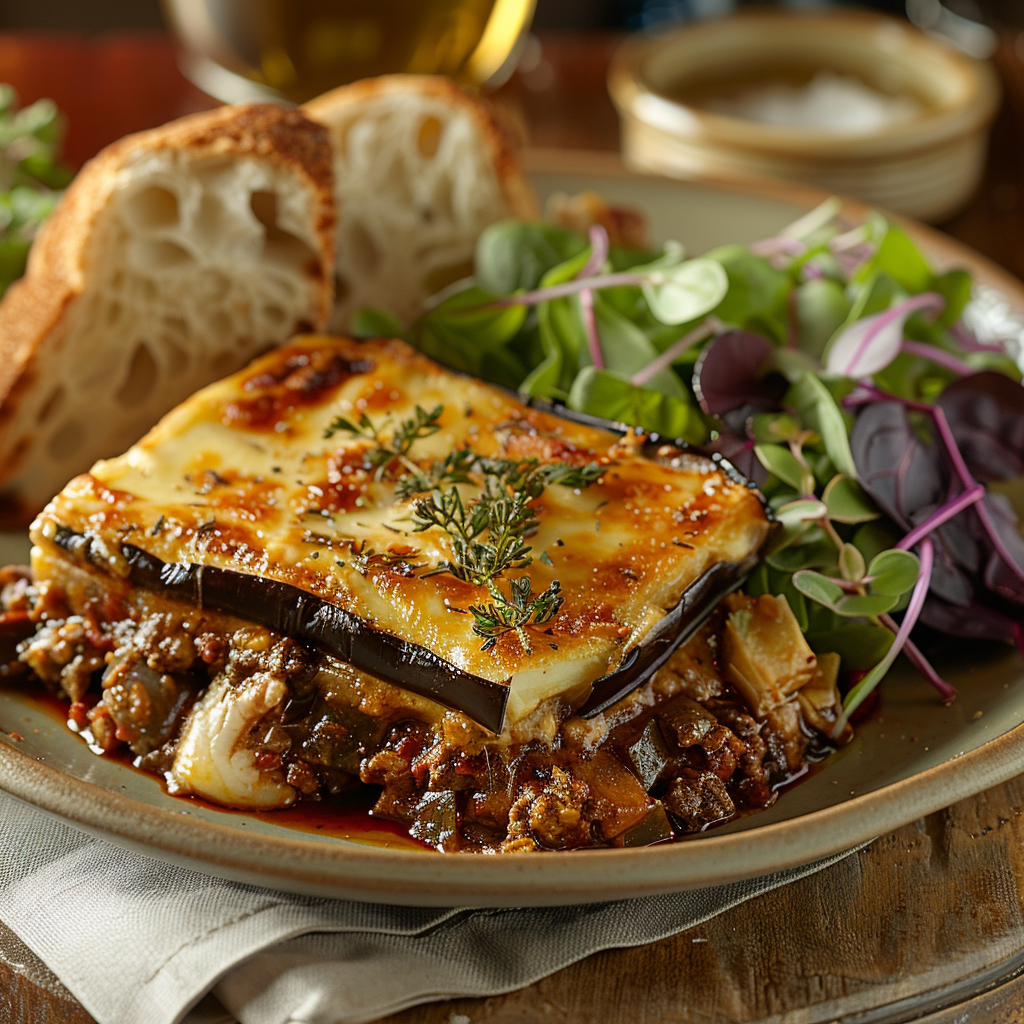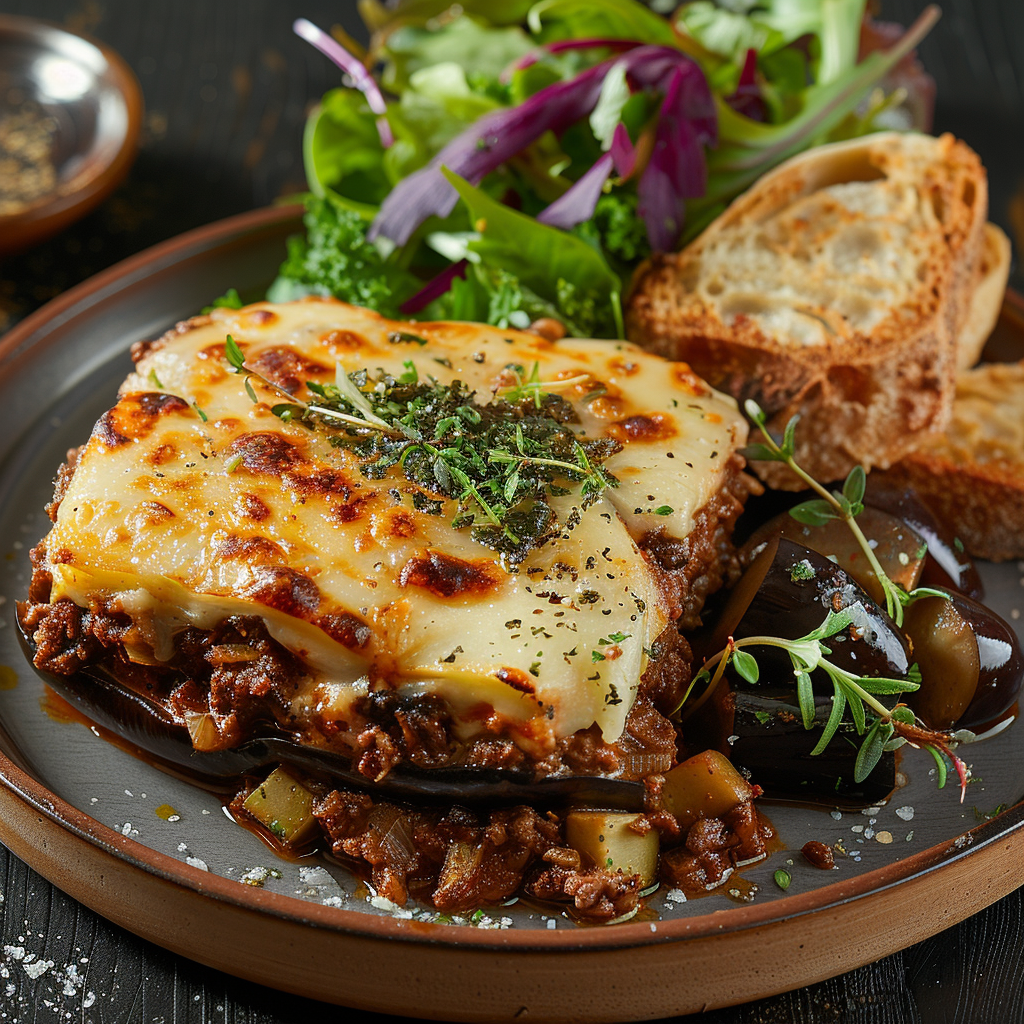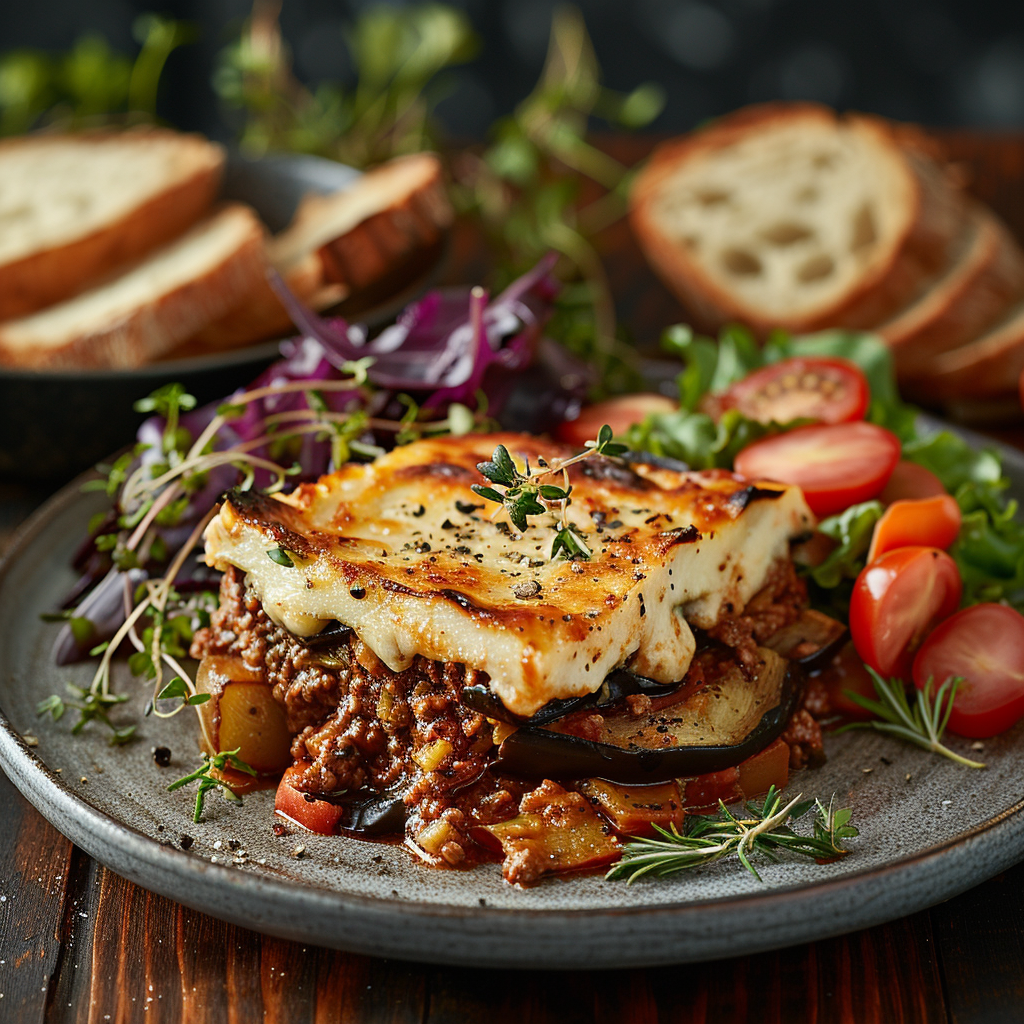
Why Greek Moussaka with Eggplant and Beef Is a Must-Try Dish
There’s something magical about the smell of roasted eggplant mingling with spiced ground beef and creamy béchamel sauce wafting through your kitchen. I remember the first time I made Greek Moussaka with Eggplant and Beef—it was for a family dinner, and I was nervous. Could I live up to my grandmother’s legendary version? To my surprise, not only did it turn out delicious, but my uncle even declared it “better than Mom’s.” Talk about pressure! This layered casserole is rich, hearty, and comforting, making it a standout dish you’ll want to share with everyone you love.
The Story Behind Greek Moussaka with Eggplant and Beef
Greek Moussaka has roots that go way back, though its modern form is believed to have been perfected in the early 20th century. The dish likely started as a simple baked eggplant dish in the Middle East before traveling to Greece, where it got its signature twist: a creamy topping made from béchamel sauce. My grandmother told me stories of how her mother would spend hours preparing moussaka for big family gatherings. Back then, it wasn’t just food—it was an event. Today, this dish bridges tradition and modernity, offering a taste of history with every bite.
Why You’ll Love This Recipe
This recipe is all about balance. The tender slices of eggplant bring a smoky sweetness, while the spiced beef adds depth and richness. Topped with a velvety béchamel layer, it’s like a warm hug on a plate. Plus, once you’ve prepped everything, assembling the dish is surprisingly easy. Whether you’re a seasoned cook or just starting out, this Greek Moussaka with Eggplant and Beef will make you feel like a culinary rockstar.
Perfect Occasions to Make This Dish
Think potlucks, holiday dinners, or Sunday family lunches. This dish shines when shared with loved ones. It’s also perfect for meal prep because leftovers taste even better the next day. I once made it for a friend’s birthday party, and everyone raved about how fancy it felt. Trust me, people will be impressed!
Ingredients
- 2 large eggplants, sliced into 1/4-inch rounds
- 1 tablespoon salt (for drawing out moisture from the eggplant)
- 2 tablespoons olive oil
- 1 pound ground beef
- 1 onion, finely chopped
- 2 cloves garlic, minced
- 1 can (14 oz) crushed tomatoes
- 1 teaspoon cinnamon
- 1 teaspoon dried oregano
- Salt and pepper to taste
- 4 tablespoons butter
- 4 tablespoons all-purpose flour
- 2 cups milk
- 2 eggs, lightly beaten
- Nutmeg, freshly grated (optional)

Substitution Options
- Ground lamb instead of beef for a more traditional flavor.
- Zucchini or potatoes if you’re not a fan of eggplant.
- Gluten-free flour for the béchamel sauce to accommodate dietary needs.
- Almond milk or another plant-based alternative for lactose-free options.
Step 1: Preparing the Eggplant
Start by salting the eggplant slices and letting them sit for 30 minutes. This step draws out excess moisture and bitterness, ensuring they roast beautifully. Pat them dry with paper towels, brush each slice with olive oil, and arrange them on a baking sheet. Roast at 400°F for 20 minutes until golden brown. Pro tip: Don’t skip the salting step—it makes all the difference!
Step 2: Cooking the Beef Filling
In a large skillet, heat olive oil over medium heat and sauté the onions until translucent. Add the garlic and cook for another minute. Toss in the ground beef, breaking it up with a wooden spoon until browned. Stir in the crushed tomatoes, cinnamon, oregano, salt, and pepper. Let the mixture simmer for 15 minutes, allowing the flavors to meld together. The aroma alone will have your mouth watering.
Step 3: Making the Béchamel Sauce
Melt the butter in a saucepan, whisk in the flour, and cook for a minute to remove the raw taste. Gradually add the milk, stirring constantly to avoid lumps. Once thickened, remove from heat and stir in the beaten eggs and a pinch of nutmeg. This sauce should be smooth and luxurious—like a warm blanket for your moussaka.
Step 4: Assembling the Moussaka
Layer half the roasted eggplant in a greased baking dish, followed by all the beef filling. Top with the remaining eggplant slices and pour the béchamel sauce over everything, spreading it evenly. Pro tip: Use the back of a spoon dipped in water to smooth the sauce without sticking.
Step 5: Baking to Perfection
Bake the assembled moussaka at 375°F for 45 minutes, or until the top is golden and bubbly. Let it rest for 15 minutes before slicing—this allows the layers to set. Chef’s tip: For extra browning, broil the top for 2–3 minutes at the end of baking.
Timing
- Prep Time: 30 minutes
- Cooking Time: 1 hour 15 minutes
- Resting Time: 15 minutes
- Total Time: 2 hours
Chef’s Secret
Add a splash of red wine to the beef filling during cooking. It deepens the flavor and adds a sophisticated touch that pairs wonderfully with the spices.
Extra Info
Did you know that moussaka is often considered Greece’s answer to lasagna? Both are layered casseroles, but moussaka swaps pasta for vegetables and uses béchamel instead of cheese-heavy sauces.
Necessary Equipment
- Baking dish (9×13 inches)
- Skillet
- Saucepan
- Whisk
- Wooden spoon
Storage
Greek Moussaka with Eggplant and Beef stores well in the fridge for up to 4 days. Cover it tightly with plastic wrap or transfer it to an airtight container. Reheat individual portions in the microwave or warm the entire dish in the oven at 350°F for 20 minutes.
If freezing, let the moussaka cool completely before wrapping it in foil and placing it in a freezer-safe bag. It can last up to 3 months. Thaw overnight in the fridge before reheating.
Avoid reheating directly from frozen in the microwave, as the béchamel may separate. Instead, thaw first and then bake gently to preserve texture.
Tips and Advice
For crispier eggplant, fry the slices instead of roasting them. If you’re short on time, use store-bought béchamel sauce. Just doctor it up with nutmeg and eggs for that homemade touch.

Presentation Tips
- Garnish with fresh parsley or thyme for a pop of color.
- Serve with a side of crusty bread or a simple green salad.
- Use a sharp knife to cut clean slices for a polished look.
Healthier Alternative Recipes
Looking to lighten things up? Here are six variations:
- Low-Carb Moussaka: Replace the béchamel with a cauliflower cream sauce.
- Vegan Moussaka: Use lentils instead of beef and cashew cream for the topping.
- Gluten-Free Option: Swap regular flour for almond or rice flour in the béchamel.
- Lighter Version: Use ground turkey instead of beef and reduce the amount of béchamel.
- Vegetable-Packed: Add layers of zucchini or spinach for extra nutrients.
- Dairy-Free Delight: Use coconut milk and nutritional yeast for a dairy-free béchamel.
Mistake 1: Skipping the Salting Step
Some folks skip salting the eggplant to save time, but this leads to soggy layers. Eggplants hold a lot of water, which dilutes the flavors. Always salt and pat them dry—it’s worth the effort.
Mistake 2: Overloading the Béchamel
A common error is pouring too much béchamel, drowning the other layers. Aim for a thin, even layer that complements rather than overwhelms.
Mistake 3: Not Letting It Rest
Cutting into the moussaka right out of the oven causes the layers to fall apart. Give it at least 15 minutes to set properly.
FAQ
What is Greek Moussaka with Eggplant and Beef?
Greek Moussaka is a traditional layered casserole featuring eggplant, spiced ground beef, and a creamy béchamel topping. It’s hearty, flavorful, and deeply satisfying.
Can I make it ahead of time?
Absolutely! You can assemble the moussaka a day in advance and refrigerate it until ready to bake. Just add a few extra minutes to the baking time.
Is moussaka always served hot?
Yes, moussaka is best enjoyed warm or at room temperature. Cold moussaka loses its texture and appeal.
Can I freeze moussaka?
Yes, moussaka freezes beautifully. Cool it completely, wrap it tightly, and freeze for up to 3 months. Thaw in the fridge before reheating.
What sides pair well with moussaka?
A fresh green salad, roasted vegetables, or crusty bread work wonderfully alongside moussaka.
How do I prevent the béchamel from curdling?
Make sure to temper the eggs by slowly adding a bit of the hot béchamel to them before mixing it all together.
Can I use other meats besides beef?
Yes, ground lamb or a mix of pork and beef are popular alternatives that add a unique flavor profile.
Why does my moussaka taste bitter?
Bitterness usually comes from undercooked eggplant. Salting and roasting the slices thoroughly helps eliminate this issue.
How many servings does this recipe make?
This recipe serves 6–8 people, depending on portion sizes.
Can I omit the béchamel sauce?
You can, but the béchamel is what gives moussaka its iconic creamy finish. Consider trying a lighter version instead of omitting it entirely.
Final Thoughts
Greek Moussaka with Eggplant and Beef isn’t just a dish—it’s an experience. From its rich layers to its comforting flavors, it’s a recipe that brings people together. Whether you’re hosting a dinner party or simply craving something cozy, this moussaka has got you covered. So grab your apron, gather your ingredients, and get ready to create a meal that will leave everyone asking for seconds.


Greek Moussaka with Eggplant and Beef
Ingredients
Equipment
Method
- Salt the eggplant slices and let them sit for 30 minutes to draw out excess moisture and bitterness.
- Pat the eggplant slices dry with paper towels, brush with olive oil, and roast at 400°F for 20 minutes until golden brown.
- In a large skillet, heat olive oil over medium heat and sauté the onions until translucent, then add garlic and cook for another minute.
- Add the ground beef to the skillet, breaking it up until browned. Stir in crushed tomatoes, cinnamon, oregano, salt, and pepper, and let simmer for 15 minutes.
- In a saucepan, melt butter and whisk in flour, cooking for a minute. Gradually add milk, stirring constantly until thickened. Remove from heat and stir in beaten eggs and a pinch of nutmeg.
- In a greased baking dish, layer half of the roasted eggplant, followed by the beef filling, then the remaining eggplant slices, and pour the béchamel sauce over the top.
- Bake at 375°F for 45 minutes until the top is golden and bubbly, then let it rest for 15 minutes before slicing.
